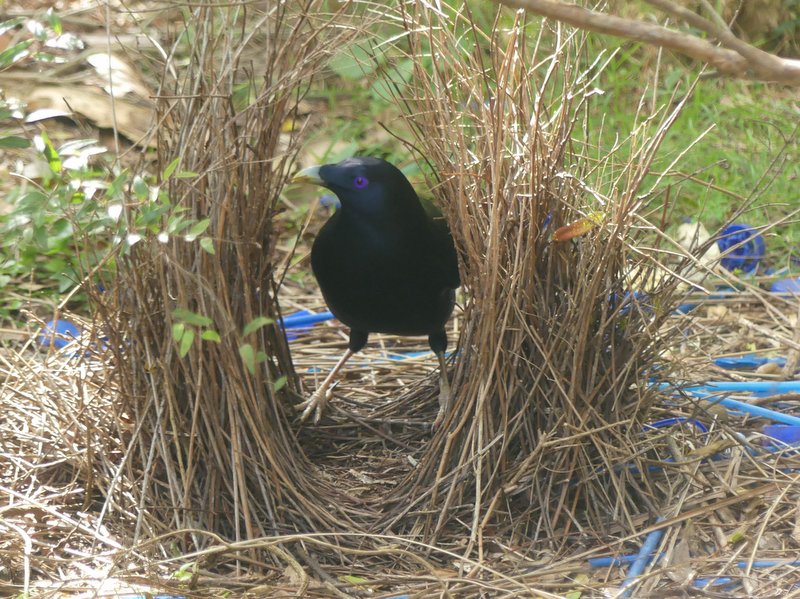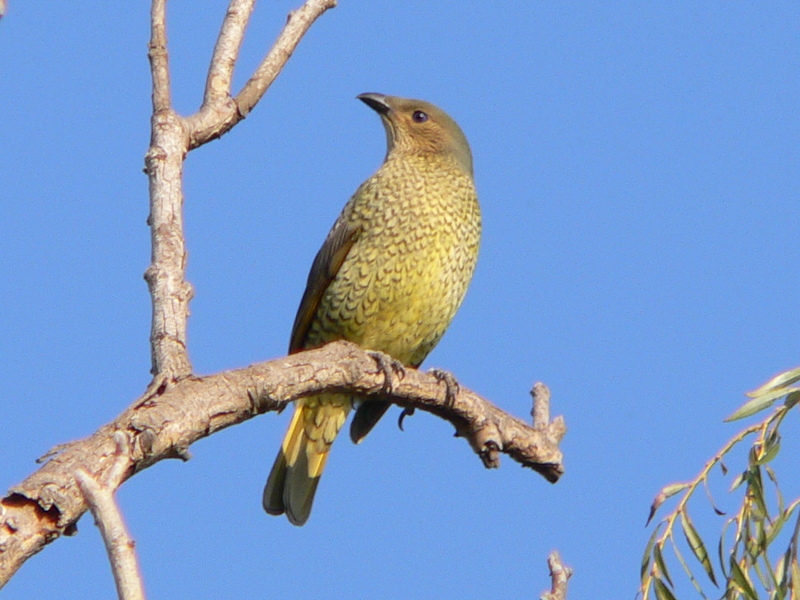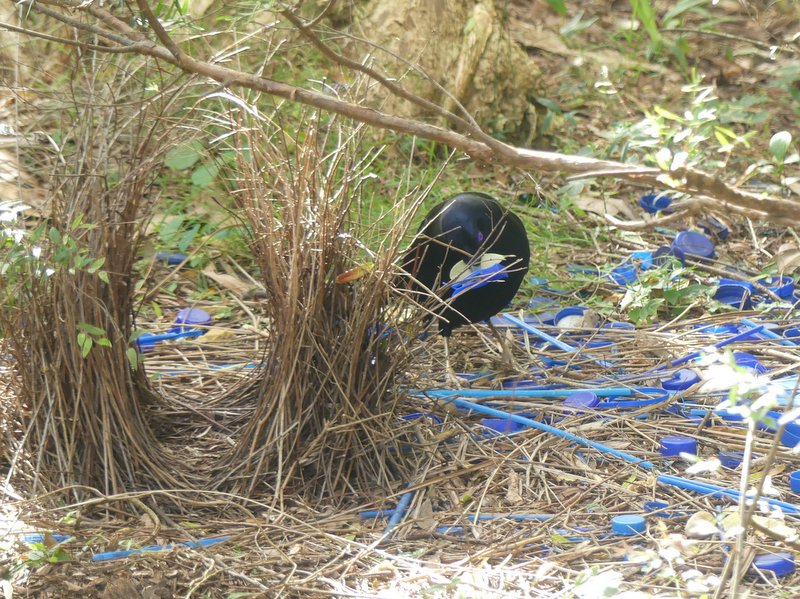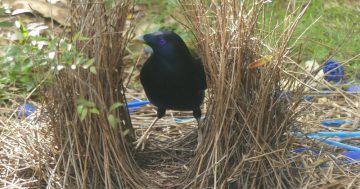
A male satin bowerbird inside the avenue of his bower. Photo: Ian Fraser.
One of the joys of living on the south side of Lake Burley Griffin is the likelihood that a satin bowerbird will visit your yard. If you’re really lucky, you might even be graced with a bower.
I also lived on the north side for many years so I can be even-handed about this; bowerbirds do sometimes stray from the National Botanic Gardens into nearby yards.
Bowerbirds are truly old Australians, perhaps nearly as old as lyrebirds, which date back 15 million years. The 27 species – including the more primitive catbirds – all live in Australia and Papua New Guinea, mostly in rainforests, with a few in the dry inland.
Only the satin bowerbird lives in Australia’s southeast, where Sydney colonists named it ‘satin bird’ for the adult male’s glossy blue-black plumage.
We see relatively few of these magnificent satin birds and often assume all the pretty olive-green and coppery birds with scalloped undersides are females.
Not so.
Males do a six-year apprenticeship wearing the same plumage as females before they moult into their satin glory at seven years of age.

The green bowerbirds are either females or immature males. Photo: Ian Fraser.
Ornithologist John Gould later introduced the ‘bower’ part of the bird’s name for the remarkable display structure it builds, although he didn’t understand its purpose.
In medieval times, a bower was a lady’s private room, although it is also a pleasant shady place under trees and Gould probably had this in mind when he thought it might be a ‘playing ground or hall of assembly’. Some people call it a nest, but it’s not that either.
In reality, the bower is an extraordinary structure that’s sole purpose is to provide a display stage for males to attract a female’s attention in order to mate with her.

A male satin bowerbird by his bower avenue, surrounded by blue straws and bottle tops he has collected. Photo: Ian Fraser.
Its construction alone is enough to command attention and it is this building skill he spends his apprenticeship attaining.
Its base comprises a deep layer of straight sticks one metre across. Then he selects thin curved sticks, each of similar length, and rams them into the platform to make an avenue of two parallel rows curving inwards (using only his beak, remember).
Finally, he paints the inside walls every morning with chewed leaves dipped in charcoal or chewed-up lichens or flowers. Really!
He also collects objects, mostly blue, to decorate it. Remote forest bowers are adorned with blue flowers, feathers and berries, as well as treasures such as snake skins and snail shells. Closer to humans, plastic rubbish, pens, bottle caps and pegs dominate.
The bower is carefully oriented in a north-south direction for maximum lighting effect on the display platforms at each end. The avenue inside the bower is where the female stands to judge his performance – and what a performance it is!
With a favourite treasure in his bill, he seems to go into a trance and behaves frenetically, his violet eyes bulging, wings flicking or held up over his back, while buzzing and clicking like a machine and imitating other bird calls.
It’s mesmerising.
If the only audience member he cares about is also mesmerised, she allows him to mate with her, then flies off to the nearby nest that she’s already built, where she’ll lay the fertilised egg the following morning.
He then has no further interest in her, and starts the process of trying to attract someone else. There’s no such thing as a sensitive new-age bowerbird.
To be fair, his life is very fraught. Males constantly go out raiding other bowers to steal choice treasures and, in the process, vandalise the bower by knocking over its sticks. The victim is forced to spend time finding new treasures and repairing the bower, rather than attracting a mate.
It’s a tough gig being a male bowerbird.
The easy gig is ours. All we have to do is watch quietly and admire the remarkable structure and performance.
If you’re not lucky enough to have a bower of your own in your yard – not many of us do – there is usually one in the National Botanic Gardens.
Or next time you’re at Tidbinbilla, ask for directions at the visitor centre.
(I have heard of a Canberran who destroyed a bower in their yard because it was ‘messy’ – I can only feel sorry for them.)
Bowerbirds are special ancient Australians and they may be in a suburb close to you.
I just drove home from the shops and one swooped across the road in front of me. I hope for your sake that they sometimes even visit you. It’s a better day when they do.
Ian Fraser is a Canberra naturalist, conservationist and author. He has written on all aspects of natural history, advised the ACT Government on biodiversity, and published multiple guides to the region’s flora and fauna.













